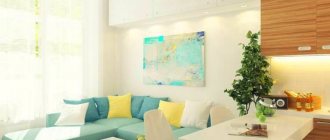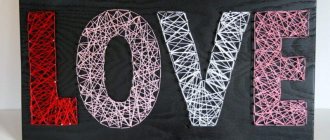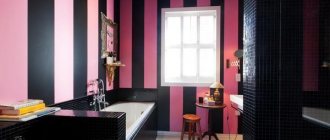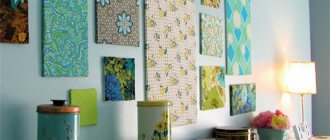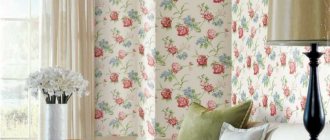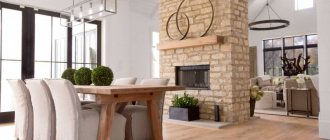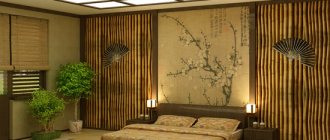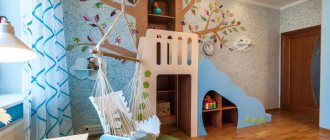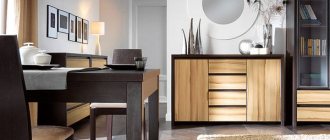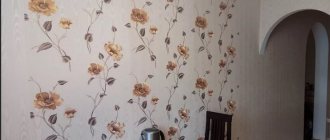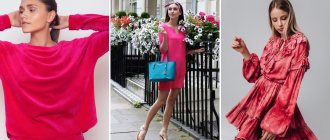Decorating walls with wallpaper is a standard option in modern design, and it seems that it will no longer be able to surprise us with anything. However, the room designers found another non-standard option for wallpapering - combining different types. There are several reasons for this decision: firstly, the combination of different types of wallpaper allows you to visually change the architecture of the room, stretch it out, expand it, etc.
Another reason is zoning, great for studio apartments and open plan apartments. In addition, gluing different types of wallpaper allows homeowners to save money. If you do not have enough wallpaper of the main color, then you can buy additional rolls at a lower cost, or even use the remnants (if any) from previous renovation work.
It seems that combining wallpaper is very simple: just use glue as you like. However, as with everything related to quality repairs, there are rules when combining different types of wallpaper. Below we will tell you more about them:
- Combine neutral shades of wallpaper, for example, bright printed ones with calm plain ones;
- Don't be afraid to combine abstraction and geometry with floral illustrations and textured surfaces;
- When choosing wallpaper, pay attention to the thickness and width of the canvas. Try to keep it the same;
- Avoid large prints in rooms with small ceilings. Combining different wallpapers in this way will further reduce the room visually;
- In a room with high ceilings, use wallpaper with horizontal stripes, this will balance the architecture of the room;
- Select and arrange wallpaper, taking into account the furniture. It should be in perfect harmony with both one type of wallpaper and another.
According to interior designers, there are many options for combining several types of wallpaper. From such an abundance of technical techniques, we can roughly highlight the following:
Wallpaper combination options
Traditional layout, in which you can focus on the wallpaper in a variety of ways:
- Equal stripes of wallpaper in a room of two different colors.
- The presence of stripes of different sizes, when the emphasis is unevenly distributed between the main and secondary tones.
- A combination of plain color wallpaper and wallpaper with drawings, patterns, and shapes.
- A background that is heterogeneous in color using both types of wallpaper with patterns.
You should pay attention to the direction of these stripes:
- Vertical combination.
- Horizontal combination.
Horizontal stripes always contribute to the visual expansion of the boundaries of space, stretching out relatively short walls. Perfect for lovers of official, classic design style.
At the same time, a vertical layout is likely to visually increase the height of the ceilings. Usually stick to pasting wallpaper strips one after another or two after one.
How to think about the placement of different wallpapers in a room: 3 main principles
Decide on accent walls
Think about which areas in the room will always be in focus and clearly visible from a distance of 2.5-3 meters - they can be emphasized with wallpaper in a rich palette, with an active design. Usually the walls get the most attention:
- which is the first thing your eye catches when entering a room;
- where the TV will hang, the fireplace will be located;
- behind the sofa in the living room, in the kitchen, in the office;
- at the dining table;
- at the head of the bed in the bedroom or nursery.
Design: Midbec
Design: Midbec
Design: Ksenia Erlakova
Design: Ksenia Erlakova
Do not hang paintings or bookshelves on a wall with a photo panel or an intense pattern on the wallpaper, otherwise the decor will distract attention from the plot and the beautiful combination of colors.
Design: Levina Yulia
Do not hang paintings or bookshelves on a wall with a photo panel or an intense pattern on the wallpaper, otherwise the decor will distract attention from the plot and the beautiful combination of colors.
Design: Levina Yulia
Walls with interesting architecture can also become focal points:
- with large niches;
- projections and semi-columns;
- differences in ceiling heights;
- other expressive design elements.
Design: Anna Razumeeva-Smirnova
Design: Anna Razumeeva-Smirnova
Design: Victoria Lazareva
Design: Victoria Lazareva
Design: Goes Orni
Design: Goes Orni
To further emphasize accent wallpaper, choose the most unobvious color present on it and choose a companion of the same shade.
Design: Solnyshkova Olga
To further emphasize accent wallpaper, choose the most unobvious color present on it and choose a companion of the same shade.
Design: Solnyshkova Olga
Don't use accent wallpaper for more than two areas. Otherwise, they will argue among themselves and get lost against each other.
If the room is small, without specific architectural elements, and nothing in its geometry catches the eye, then it is better to abandon accent patterns and colors on the walls and combine two or three calm designs. It can be:
- dim plain backgrounds;
- restrained pattern or geometry in a muted palette + background similar in visual weight;
- two calm identical drawings on different scales - one larger, the other smaller.
Design: Rebel Walls
Design: Rebel Walls
Design: DVEKATI
Design: DVEKATI
One wall - one design
Do not combine several types of wallpaper on one wall; glue each of them from corner to corner, protrusion, niche or architectural element - this way the combination will look more complete. If you still want to center the coating, highlight it with moldings or choose a companion with a non-contrasting background.
Design: Cozy Houzy
Design: Cozy Houzy
When choosing wallpaper for a room, do not forget about textiles. The color and texture of pillows, curtains, upholstery fabrics and rugs can help enhance certain colors or balance out too-contrasting wallpaper combinations.
Design: MO Interior Design
When choosing wallpaper for a room, do not forget about textiles. The color and texture of pillows, curtains, upholstery fabrics and rugs can help enhance certain colors or balance out too-contrasting wallpaper combinations.
Design: MO Interior Design
Do not use more than three designs from a collection
The variety of designs and palette of backgrounds does not mean that you need to glue them all.
Selecting wallpaper texture
If, when designing a future interior, there is a desire to use an unusual style of wall decoration, then textured, embossed wallpaper will come to the rescue. It is important to remember that you can safely hide all defects and irregularities under layers of embossed wallpaper.
This way you can hide what you don’t want from your eyes and not worry about the color - even light shades will skillfully adapt to the overall appearance of the wall due to the pressed materials in the wallpaper.
A competent combination of textures is an important component of wallpapering two types
Before you hang different wallpapers, you should think carefully about what materials they should be made of. First of all, you need to start from how certain materials will show themselves in practice. For example, some wallpapers should not be used in the kitchen or bathroom, but there are types that will fit only into the most sophisticated and luxurious interior.
Types of textures can be very different, here are the most common ones:
- Paper;
- Vinyl;
- Non-woven;
- Textile;
- Liquid.
A successful combination of different types of canvases guarantees success in interior design
The main thing is to carefully select textures and focus on their equal thickness. This will prevent the occurrence of sloppy seams and joints.
Accent wall
Modern ideas in using wallpaper of two colors as the main decoration in the interior suggest a combination of an accent wall of one color with wallpaper of other shades. It is important not to overdo it by looking at too bright and saturated colors in the rest of the room. A win-win option would be plain wallpaper or with a minimum number of patterns (often small abstract patterns).
When using an accent wall, you can create a rich look for the room by choosing the same colors as the main wall, shades for furniture and decorative elements.
Note!
Glass wallpaper - what is it? Pros and cons, types, features, characteristics, photos of design and combinations in the interior
Plain wallpaper - 150 photos of modern design. Rules for choosing and combining wallpaper in the interior: kitchen, bedroom, living room, hallway
Wallpaper framed on the wall in the interior: photos of original design and beautiful decor
These can be plant pots, chairs or a table (but not both options at once - there will be an excessive clutter of bright colors), a picture or its frame, photo wallpaper (necessarily small in size if there is an accent wall), a carpet, a shelf, etc.
A 3-D photo or panoramic image will visually expand the area of the room and visually increase the size of the latter. Proper pasting of the walls is necessary, since with the help of these simple manipulations you can both decorate the walls of the room and give them an awkward look.
What wallpapering options are popular today?
Citizens' knowledge about fashion trends and new design solutions has been cut short since the end of the last renovation. There are rarely people who would follow the world of finishing if the issue of repair is not pressing. To quickly understand modern fashion, it is recommended to consider several trend trends:
- Color combination - different tones of rolls are used. The most advantageous color branches are blue, beige and gray;
- Combination with patterns and ornaments - it is very important to find a color relationship here. The color of the same pattern should match the use of a different type of wallpaper. Designers try to visualize the final result in advance in order to predict in advance whether there will be reflection. This is also one of the beneficial ways to zone a nursery or living room;
- Mixing geometric patterns with stripes is a new movement that is most often chosen by the younger generation. The room becomes bright and unusual. Using this style in the bedroom is hardly a good idea, but decorating the living room and hallway where friends gather or children play is a win-win option.
These are not all gluing options used by designers. Below you will have to understand the intricacies of the combination; additional recommendations and photos will be highlighted.
To quickly understand modern fashion, it is recommended to consider several trend trends.
Wallpaper in two colors for the hallway
Since the corridor is a passage place, the decoration of its walls is approached with special care. In addition to regular paper rolls, it is recommended to use:
- Vinyl flooring is a durable and, in some cases, breathable material. In the case of a base, it is better to use non-woven fabric; it is easier to glue and does not stretch. You can hide uneven walls.
- Glass wallpaper is a material with an uneven, patterned relief. Its huge advantage is that it can be used to cover the entire wall, and only then paint it in suitable shades, and not improvise with the selection of wallpaper in two colors.
The choice of color for the hallway should be made in accordance with the general background in other rooms. The corridor should look long and spacious enough, so variegation should be avoided.
You can use a strip of material of a different color in the middle of the wall against the background of plain wallpaper, which will definitely stand out and attract all attention to itself. A horizontal arrangement of wide strips of wallpaper will also allow you to lengthen the corridor.
Narrow stripes will create the opposite effect. An option is considered beautiful when the wallpaper of two colors in the hallway contrasts sharply with each other and divides the room into different sections. In this case, it is advisable to make the upper part of the wall in a monochromatic light shade, and the lower part in dark colors, showing imagination in the selection of drawings and patterns.
Features of combining wallpaper of two colors in the living room
Many people use the hall in two ways at the same time - a shared recreation area with family and a sleeping place. It is very difficult to make a room comfortable for two purposes at once. For example, in bedrooms they use more intimate shades to promote relaxation, in separate living rooms they use light and bright shades to raise tone.
In order not to make a mistake in the design of pasting different types of wallpaper, you can decorate the room with a combination as follows:
- The designers have put together ready-made combinations based on the color palette - using beige and white, burgundy and pink, blue and white, silver and purple;
- As for the types - matte is combined with glossy, smooth with rough;
- As for the print, geometry goes well with abstraction, while flowers and plants look good on a plain base;
- If the room is large and bright, you can easily use deeper shades and bright geometry.
Many people use the hall in two ways at the same time - a shared recreation area with family and a sleeping place.
Wallpaper in two colors for the living room
The selection of colors can be very diverse, but it must satisfy the needs of the whole family, since this is where they spend most of their time.
To choose the right color, it is better to think through the interior down to the smallest detail; sometimes you already have furniture and decorative elements, so that, based on them, you can choose the right background. Both sharp contrasts of colors (white/beige/flesh and green/blue/brown/black shades) and shades of the same color will be beautiful. In the case of the latter option, it is important to maintain color temperature, saturation, and lightness.
To decorate a room with wallpaper of two colors, there are different combination options:
- The attractiveness lies in the accent when using a wallpaper panel, that is, a kind of piece of fabric in a frame. A particularly beautiful contrast is created if such patches of different colors and textures, filled with patterns or geometric shapes, are combined with plain wallpaper. For a hall, it is preferable to use one wide (but not the entire wall) panel, involuntarily reminiscent of a painting, or several square shapes of small diameters.
- Photo wallpaper is an excellent solution for spacious rooms. Photo wallpaper does not have to cover the entire wall, although this option is also good. A beautiful background is made up of photo wallpapers that do not even reach literally 20-30 centimeters to the edges of the wall, being only part of the overall design ambiance, and not the main accent. A unique option using photo printing will also be the image of small details (animals “sitting” on the floor, a view from a window of a forest or coastal area, etc.). Attention should be paid to all boundaries and joints to prevent layering on another part of the wall.
Current options for photo printing on the entire wall: a night city, a three-dimensional river with a bridge, a birch grove, ancient figures and even scenes of any actions of the heroes, etc.
- The highlight of the layout will be added by molding - a volumetric overlay designed for interior decoration. They can either differentiate between photo wallpaper and panels, or draw a line between wallpaper in two colors on one wall, as if dividing it into sections.
How to combine wallpapers with each other: we analyze popular methods
Background + background
There are many options for such combinations, but the calmest and most harmonious is a pair of coatings of two or three shades of the same color of different lightness and strength, for example, medium gray with graphite, light brown with brown, green with dark green. In such combinations, the depth of the chosen color will be fully revealed and unnecessary variegation will not appear.
Another option is to collect a pair or trio of one or two very calm colors and one bright one. Let the proportion of bright colors be less than the proportion of calm colors - this will help balance the combination.
Design: Anastasia Kudryashova
Design: Anastasia Kudryashova
Background + pattern or geometry
A classic, uncomplicated combination. If you want uniform, dim walls, for accent coverings choose companions with the same background; if contrasting, choose something much lighter or darker than the background.
Design: Nadezhda Nosova
Design: Nadezhda Nosova
Design: Marina Sargsyan
Design: Marina Sargsyan
Design: Yulia Khokhlova
Design: Yulia Khokhlova
Traditionally, wallpaper with a pattern or geometry is used to cover accent walls or parts of walls, but you can do the opposite: for example, cover a niche or protrusion with background wallpaper, and use active wallpaper to cover the space around it. At the same time, you should not cover the entire room with a bright coating: limit yourself to covering only the wall on which the niche or ledge is located.
Design: ST-Interiors
Design: ST-Interiors
Design: Milassa
Design: Milassa
Large drawing or geometry + the same, but small
Having settled on such a combination, remember: large prints visually reduce the surface, small ones, on the contrary, make them a little larger. Therefore, for accents, choose wallpaper with a large pattern or geometry, and let the small one act as a background.
Drawing + geometry
Such combinations are ideal for classic interiors, where geometry (usually a stripe or a checkered pattern) acts as a companion to a pattern (damask, flowers). Choose a calm, dim geometry - then it will not get boring and will help to unobtrusively structure the interior, which is never superfluous for classics. Combinations of photo wallpapers with flowers, combined with stripes in the interior, are also good.
Photo: Alexander Klevtsov
Photo: Alexander Klevtsov
Design: After the Antique
Design: After the Antique
Design: Milassa
Design: Milassa
Two or three different designs
In such multi-component combinations, the main thing is to maintain proportions: the more active the pattern or color, the less such wallpaper there should be in the interior. To make the composition look holistic, choose options that are similar in intensity and visual weight. Optimal combination methods:
- include accent coatings in the interior in the form of decorative inserts in moldings;
- place the drawings on different sides of the room if it is large and has many corners and niches.
- cover the inside of a bookcase or cabinet with one type of wallpaper.
Design: VV Design
Design: VV Design
Idea to note: cover one of the walls with wallpaper with a pattern...
Design: Svetlana Herzen
Idea to note: cover one of the walls with wallpaper with a pattern...
Design: Svetlana Herzen
... and duplicate them on the adjacent wall, but as an insert on a neutral background, decorated with moldings.
Design: Casamance
... and duplicate them on the adjacent wall, but as an insert on a neutral background, decorated with moldings.
Design: Casamance
Wallpaper in two colors for the kitchen
First of all, it is necessary to indicate that the selected wallpaper must be moisture-resistant and durable. The spacious kitchen is pure permissiveness for the imagination. You can combine plain light wallpaper and other wallpapers that are sharp in contrast, have large patterns, drawings, and images of living creatures.
In addition, you can try one shade with two or three different colors. However, you should be wary of slipping into bad taste: the colors should be in good harmony with each other.
Small kitchens can be visually enlarged: the ceiling and upper part of the walls are decorated with light shades, and the lower part, in contrast, with dark colors. Moreover, the longer the light part of the wallpaper and the smaller the size of the wallpaper in dark or bright colors, the better the visual effect. To do this, you will need a competent horizontal layout.
You can also create a smooth transition by combining wallpaper of two colors: wallpaper of different colors is separated by a neutral shade with abstract small patterns located on an adjacent wall or between different colors of wallpaper on the same wall.
How to properly glue two types of wallpaper
Wallpapering is not a difficult task, but it requires some knowledge. If wallpaper with two types of colors or textures is hung in a room, the rules apply the same as for standard wall coverings.
It is important to consider that different textures require the use of certain types of glue.
Textile, vinyl and paper wallpapers are glued with various substances
Masking the joints is necessary if wallpaper of different textures is used.
To do this, you can purchase special tools:
- Moldings;
- Reiki;
- Tapes;
- Curbs.
It is important to carry out preliminary preparation of the walls even before wallpapering the room. Each wall must be cleaned of old paint or wallpaper, the remaining plaster removed, puttyed and cleaned. Depending on the type of wallpaper strips, the walls are sanded more or less thoroughly. If the room is damp, you need to use anti-mold preparations.
Related article: How to choose the right color and style of curtains for the living room
Zoning using wallpaper
Modern living rooms simply need a new, creative design, which ideas for combining wallpaper of two colors can easily cope with.
In the case of the living room and kitchen, using a combination of wallpaper of two colors, it is possible not only to complement the design of a bright, lively interior or to hide uneven walls or any defects, but also to zone them in the absence of a partition or wall between both rooms.
What is important here is a smooth transition and compatibility of the general background, as well as the absence of merging and delimitation of zones within which the needs of household members for eating and rest are satisfied.
Such experiments are good if you have an idea for a budget renovation, and the best way seems to be to give more visual effect using wallpaper in 2 colors.
Which wallpaper should you choose?
So, you are interested in the idea of covering your walls with two types of wallpaper, but you can’t decide which type of material to prefer? First of all, pay attention to the practical possibilities of wallpaper for walls . If in rooms such as a bedroom or living room, almost all the wallpaper will remain intact for a long time, then the humid conditions of the kitchen or bathroom can easily damage its structure, ruin the paint and appearance.
Fortunately, today manufacturers are not limited to producing one type of wallpaper, and the market assortment is filled with many ultra-durable and weather-resistant wallpaper coverings.
The following are widely used for combination:
- paper wallpaper - suitable for rooms with dry conditions, in which it is planned to create a temporary design in durable shades (living room, hall, bedroom, study, children's room). Thanks to the possibility of purchasing multi-layer paper coverings, the use of wallpaper of this type for combination is possible even in areas with a high risk of mechanical damage. Can be combined with almost any type of wallpaper;
- vinyl wallpaper - has increased practical properties: they are not only quite strong, but are also characterized by additional elasticity compared to other finishing materials. And thanks to the special protective properties, the threat of moisture in the bathroom, kitchen or even in the hallway is not terrible for materials of this type. The best option for combining with vinyl is paper wallpaper;
- non-woven wallpaper - most often used in areas with insufficiently prepared surfaces. Scratches, dents and other defects on the walls are ideally masked using elastic non-woven fabric. And the relief texture of some types of such wallpaper helps to emphasize the individualism of the design. Thanks to the possibility of constant repainting, non-woven wallpaper can be perfectly combined with paper and vinyl coverings of absolutely any shade;
- textile wallpapers are among the most spectacular and expensive. Most products of this type are not moisture resistant, which means that textiles are best used for decorating a living room or bedroom. The soft and pleasant texture allows you to combine such wallpaper with paper and non-woven wallpaper;
- liquid wallpaper , which is an analogue of decorative plaster - they can be used almost everywhere. But do not forget that moisture ingress will cause additional difficulties when cleaning the walls from such materials. Due to the relief texture, stylish combinations of liquid wallpaper with non-woven and glass wallpaper are possible.
These are not all wallpaper options for walls. Pasting two types of wallpaper requires a careful approach to the selection of such materials depending on their practical properties. That is why, ask experts in advance about the range of wallpaper products - and make a choice based on the ratio of their price and quality.
Remember! An ideal design for wallpapering two types is only possible if you choose the right textures and can find canvases that match each other in thickness.
You can find out how to cover a room with two types of wallpaper without compromising the integrity and harmony of the design from specialists or consultants in stores. But even a photo of two types of wallpaper will help you decide in advance how you see your future interior.
Hall decoration options
The whole family gathers in the hall in the evenings, where they welcome guests and celebrate holidays. This room is a kind of calling card for the owners of the house. Therefore, renovations in the hall must be approached with all responsibility.
Ideas and options for decorating the hall can be gleaned from these photos.
The walls in the hall are often decorated with niches, arches, and columns. These designs are decor in themselves; it is important not to overdo it with their decoration. Niches and other recesses look impressive when they act as an accent. They are covered with contrasting wallpaper, often in dark shades. A similar design is shown in the photo.
Columns in the hall do not always bring aesthetics; they can be part of the supporting structure in old houses. These elements are usually masked and hidden, and with the help of two types of wallpaper they can become the highlight of the room. Like in this photo, for example:
Advice! To properly think through the design in the room, you need to take into account all the furniture and interior items.
Bright accents look impressive - there should be few of them, and they should be small. Options in the photo.
In a large hall, zoning using two types of wallpaper is appropriate. Finishing can complement the existing delimitation of space (partitions, different furniture) or create it independently.
Wallpaper of different colors can be used to divide a room into two parts with different purposes. This could be an office and a living room, or a bedroom and a living room. A similar design is shown in the photo.
Basic rules
To hang two types of wallpaper, strict adherence to certain rules is required:
- Color solutions need to be implemented not only in wallpaper combinations, but also in furniture, curtains, various items and accessories. This way the interior will look more harmonious.
- The combination of plain materials and products with ornaments is considered one of the most successful.
- It is not recommended to use combinations of variegated tones. It is better that one stripe is bright, and the second is a more muted shade.
- If the main material has a floral pattern, then a combination with wallpaper, the texture of which is made in the same style, would be an excellent solution.
- Products with geometric shapes are recommended to be combined with abstraction.
- When using materials with different textures, it is necessary to mask the joints using moldings, slats, tapes and borders.
- Triple combination is possible only in the case of large rooms; in small rooms the interior will look too bulky.
- Both glue and wallpaper need to be bought in the same store, it is better if they are from the same manufacturer.
- Preliminary marking is required.
- It is recommended to start pasting from the top.
- When applying products, it is important to leave a reserve in case they move away after drying.
The combination of two types of wallpaper with different patterns, textures and colors allows you to create a truly original interior. It’s just important not to rush and first check how good this or that combination will look on the walls.
Rules for combining wallpaper and textures
When covering walls with different wallpapers, it is necessary to take into account the rules for combining shades, textures, and patterns on surfaces. The following characteristics must be taken into account:
- ceiling height;
- room dimensions;
- compatibility of textures;
- color scheme (light, dark);
- quality of canvases.
Ceiling height
The type of ornament, shade and texture of the material depend on the height of the ceiling. When the height of the room is less than 2.5 m, materials of light shades, without expressive texture, with medium and small ornaments are needed.
Using a light-colored canvas as a background and inserts of canvases with a fuzzy texture or a pattern with vertical stripes will help to visually adjust a room with low ceilings. To visually enlarge a compact room, combine wallpaper of different shades.
For apartments with high ceilings, it is optimal to hang two types of wallpaper with large ornaments and large-scale drawings. Horizontal division of walls is allowed. When selecting, it is important to combine the tone and texture of materials.
Room dimensions
When combining different types of wallpaper, the size and layout of the space are taken into account. For large areas, materials in dark and rich colors are used to visually make the room smaller. It is also optimal to combine wallpaper materials with a subtle pattern or geometric pattern, plant patterns, flowers, leaves. You can use abstractions and geometric lines to visually adjust the area.
Light-colored canvases are suitable for small apartments. The texture of the materials should be smooth or with a fine textured pattern, thin engraved ornaments.
When using different wallpapers, the geometry of the room is taken into account. The elongated room is decorated with 2 types of materials; in short areas, light sheets are glued with an overlap on dark wallpaper. This technique helps to align the geometry of the room.
Selecting a texture
Wallpaper of two colors should be combined in texture and sheet thickness. When fixing canvases on a flat surface, materials of the same type are optimal. When joining sheets in the corner areas of a room, you can use different thicknesses of the sheets; the textures of the joining blocks may also differ.
You can beautifully stick wallpaper with different thicknesses and textures using adhesive bases suitable for the type of raw material. The compositions differ for sheets on non-woven and paper backings, vinyl and structured sheets. For complex combinations, glue with a universal composition is suitable.
Light or dark?
In a room with a light interior or a monochrome design, you can decorate 1 wall with dark-colored wallpaper, while the remaining surfaces are decorated with materials in soft pastel colors. The design technique will allow you to create accent areas in space without visually reducing the area of the room. For dark rooms, you can create a light area using appropriate wallpaper on the wall opposite the window opening.
Why is this needed?
It doesn’t always turn out that the interior of a particular room is as functional as we would like it to be. Sometimes you have to look for some way to solve it. In addition, it is often necessary to combine different colors in the interior of a particular room. We are talking about the living room, bedroom, children's room and so on.
Remember! This approach is characterized by a high level of practicality, since you do not need to resort to radical changes to the interior or expensive repairs.
Of course, using companion wallpaper requires certain skills in combining colors and surfaces. On the other hand, for this it is not at all necessary to be a high-level specialist in interior design. It is enough to understand the basic principles and look at photos with examples of how certain solutions were implemented in practice. As a rule, regardless of the style in which the apartment is decorated, what furniture and accessories are used in it, the principles of zoning remain quite universal.
So, let's look at the main arguments in favor of dividing space into functional zones:
- When a small room needs to be divided, but you don't want to use bulky and thick cabinets and shelves to avoid even further reducing the space in the room.
- Each individual part of the room should be highlighted with at least an individual color. This will emphasize its purpose.
- If several people live in a room at once (for example, children of different sexes), then with the help of zoning you can create a play space for each child. The same applies to children of different ages.
- You can highlight the main part of the room by visually separating it from secondary corners. This can be done using different shades of wallpaper.
- Often, similar methods of decorating space are used in the case of one-room apartments with a combined living room and kitchen, or for studios.
As a rule, with all this, it is advisable to use not a monochrome, but a more contrasting color scheme. Also suitable is the option of combining wallpaper with patterns/ornaments and plain companions without any pattern. By the way, with a competent approach, you can somewhat “correct” certain shortcomings in the room. Of course, we are talking exclusively about visual correction of shortcomings, for example, the size of the room is too small or the configuration is not entirely successful.
